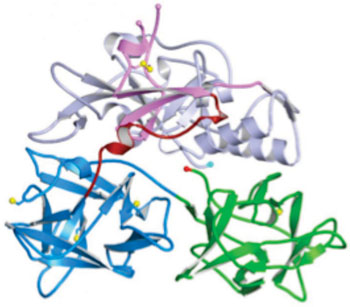Crystal Structure of CARDS Toxin Expected to Advance Respiratory Disease Treatment
By LabMedica International staff writers
Posted on 21 Apr 2015
A recent paper described the molecular structure of Mycoplasma pneumoniae's Community Acquired Respiratory Distress Syndrome (CARDS) toxin and explained how knowing this structure may lead to advances in the prevention and treatment of diseases caused by this respiratory pathogen.Posted on 21 Apr 2015
Mycoplasma pneumoniae is a very small bacterium in the class Mollicutes. It is a human pathogen that causes the disease mycoplasma pneumonia, a form of atypical bacterial pneumonia related to cold agglutinin disease. The organism is characterized by the absence of a peptidoglycan cell wall and resulting resistance to many antibacterial agents. As part of the infectious process, the bacterium expresses the 591-amino acid long CARDS toxin virulence factor with both mono-ADP ribosyltransferase (mART) and vacuolating activities. CARDS toxin binds to human surfactant protein A and annexin A2 on airway epithelial cells and is internalized, leading to a range of pathological genetic events.

Image: Molecular model of CARDS toxin, which was first described in 2006 (Photo courtesy of the University of Texas Health Science Center at San Antonio).
In a paper published in the April 7, 2015, online edition of the journal Proceedings of the National Academy of Sciences of the United States of America (PNAS) investigators at the University of Texas Health Science Center (San Antonio, USA) presented the X-ray crystallography-derived structure of CARDS toxin. The results depicted a triangular molecule in which N-terminal mART and C-terminal tandem beta-trefoil domains associated to form an overall architecture distinct from other well-recognized ADP-ribosylating bacterial toxins. The investigators demonstrated that CARDS toxin bound phosphatidylcholine and sphingomyelin specifically over other membrane lipids, and that cell surface binding and internalization activities were housed within the C-terminal beta-trefoil domain.
Recombinant CARDS toxin administered to naive mice induced an allergic-type inflammatory response and airway hyperreactivity, suggesting that an analogous response in humans might play a causal role in M. pneumoniae-associated asthma.
"We know a lot about how the toxin works, but we did not have its three-dimensional structure," said contributing author Dr. Joel B. Baseman, professor of microbiology and immunology at the University of Texas Health Science Center. "The structure shows us the molecular architecture of the protein, which permits the rational design of effective drugs and vaccines to neutralize the injurious effects of CARDS toxin. Blocking the toxin could prove to be a major advance in the prevention and care of a wide range of acute and chronic airway diseases."
Related Links:
University of Texas Health Science Center













